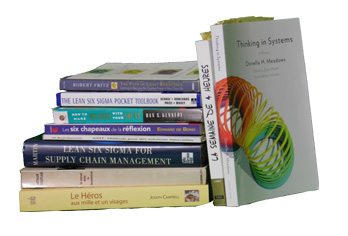Bienvenue, identifiez-vous
BiBLIOgraphie
|
Vous aurez la possibilité d'approfondir les sujets abordés dans le récit grâce à la reproduction de la bibliographie intégrale utilisée par l'auteur pour la rédaction de cet ouvrage.
Par ordre d’apparition des concepts abordés dans l'ouvrage : |
|
CHAPITRE 1 - L’APPEL A L’AVENTURE
Joseph CAMPBELL (1949) “The Hero with a Thousand Face”, Fontana Press.
NASA (1968) “Mission APPOLO 8 Press Kit ” – Consulté le 25 Juillet 2009 sur : http://www.hq.nasa.gov/office/pao/History/alsj/a410/A08_PressKit.pdf
NASA (2009) “Archives”, Consulté le 25 Juillet 2009 sur : http://www.hq.nasa.gov/ office/pao/History
Michael GEORGE (2005) “Lean Six Sigma pour les services : Comment utiliser la vitesse Lean & la qualité Six Sigma pour améliorer vos services et vos transactions”, Paris, Maxima.
CHAPITRE 2 - LA MISSION
C. Northcote PARKINSON (1955) “Parkinson's Law”, The Economist.
Michael GEORGE, David ROWLANDS, Mark PRICE, John MAXEY (2005) “The Lean Six Sigma pocket toolbook”, New-York, McGraw-Hill.
Paul MILLIER (2002) “L’étude des marchés qui n’existent pas encore“, Paris, Editions d'Organisation.
Noriaki KANO (1984). “Attractive quality and must-be quality”, Journal of the Japanese Society for Quality Control.
Tony BUZAN, Barry BUZAN (2003) “Mind Map : Dessine-moi l'intelligence 2ème Ed.”, Paris, Editions D’Organisation.
Paul HERSEY, Kenneth H. BLANCHARD, Dewey E JOHNSON (2007) “Management of Organizational Behavior: Leading Human Resources (9th ed.)”, New Jersey, Prentice Hall.
CHAPITRE 3 - DEFINITION DES PARAMETRES ORBITAUX
Rini VAN SOLINGEN, Egon BERGHOUT (1999) “Goal / Question / Metric Method”, New York, McGraw-Hill Education
Florent FOUQUE (2008) “Pareto VS Benford - 3ème volet de la guerre des indicateurs”, Consulté le 25 Juillet 2009 sur : http://leansixsigma.free.fr
Maurice PILLET (2003) “Six Sigma : comment l’appliquer”, Paris, Editions D’Organisation.
Georges ECKES (2003) “Six Sigma en action”, Paris, Village mondial.
Ait Belkacem El HADI (2005) “Puissance Six Sigma”, Paris : Dunod: "L'Usine nouvelle".
James W. MARTIN (2007) “Lean Six Sigma for Supply Chain management”, New York, Mc Graw Hill.
CHAPITRE 4 - MISE EN ORBITE
Richard KOCH (1998) “The 80/20 Principle: The Secret of Achieving More with Less”, New York, Broadway Businessy.
Joël de ROSNAY (1977) “Le Macroscope”, Paris, Seuil.
Peter M. SENGE (1994) “The Fifth Discipline: The Art & Practice of the Learning Organization”, New York, Doubleday Business.
Herbert SIMON (1955) “A Behavioral Model of Rational Choice” Quaterly Journal of Economics, Vol 69, pp99-118
CHAPITRE 5 - LE DRAPEAU DU LSS
Roni HOROWITZ (2004) “ASIT Méthode pour des solutions innovantes”, Bordeaux, SolidCreativity.
Edward De BONO (2005) “Les six chapeaux de la réflexion : la méthode de référence mondiale”, Paris, Editions D’Organisation.
Florent FOUQUE (2009) “Comment accroître la performance d’un service en évitant les sureffectifs ? ”, Supply Chain Magazine N°35 – Juin 2009, pp78-81.
ECR France – Gencod EAN France (2001) “Plan, Prévisions et Approvisionnements concertés (Manuel de mise en oeuvre du CPFR)”, Paris, Coédition ECR France – Gencod.
EAN France Thierry JOUENNE, Emanuelle RENON et Jean-François DANQUIGNY (2000) “CPFR (Concepts, carte routière et premiers pilotes internationaux)”, Paris, Jouwen Editions.
Florent FOUQUE (2008) “Une collaboration plus étroite entre les industriels et leurs distributeurs pour une performance accrue de l’ensemble de la chaîne logistique”, Thèse professionnelle, EM-Lyon.
Robert FRITZ (1989) “The Path of Least Resistance: Learning to Become the Creative Force in Your Own Life”, New York, Fawcett Books.
Carine BUHMANN (2001) “La Pyramide Alimentaire Pour Manger Équilibré Avec Plan Pour 2 Semaines”, Delémont, Viridis.
CHAPITRE 6 - RETOUR A LA BASE
Arthur KOESTLER (1968) “Le cheval dans la locomotive”, Paris, Calmann-Levy.
Donella H. MEADOWS (2008) “Thinking in systems”, Vermont USA, Celsea Green Publishing.
Timothy FERRISS (2007) “The 4-Hour Workweek”, New York, Crown Publishing.
Dan S. KENNEDY (1996) “How to Make Millions With Your Ideas: An Entrepreneur's Guide”, Plume Books.
ANNEXE
François RICHAUDEAU, Michel GAUQUELIN, Françoise GAUQUELIN (2004) “Méthode de Lecture rapide”, Paris, Retz.
Florent FOUQUE (2009) “Modélisation Systémiques – La lecture rapide” Consulté le 25 Juillet 2009 sur : http://analysesystemique.free.fr

